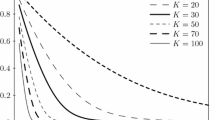Abstract
Cognitive radio (CR) has attracted considerable attention as a promising technology for solving the current inefficient use of spectrum. In CR networks, available sub-channels are dynamically assigned to secondary users (SUs). However, when a primary user accesses a primary channel consisting of multiple sub-channels, data transmissions of the SUs already using the sub-channels may be terminated. In this paper, we analyze the performance of dynamic spectrum handoff scheme with channel bonding, in which the number of sub-channels used by an SU are variable. We model the multichannel CR network as a multiserver priority queueing system without waiting facility, deriving the blocking probability, the forced termination probability and the throughput for SUs. In terms of the way of forced termination, we consider two policies; one is that SUs using the largest number of sub-channels are forced to terminate their transmissions, and the other is that SUs using the smallest number of sub-channels are chosen for termination. The analysis is also validated by simulation. Numerical examples show that in both forced-termination policies, the throughput of SUs that are forced to terminate their transmissions degrades as the offered load to the system increases.

















Similar content being viewed by others
Notes
The processes of spectrum occupation in [7, 8] and this paper are analyzed by continuous-time Markov chains. However, there are no specific descriptions of the calculation method for stationary probabilities in [7, 8]. In this paper, stationary probabilities are computed by a matrix analytic method [9] due to the block-tridiagonal structure of \(\user2{Q},\) which is resulting from the analytical model in the paper.
References
Kannappa, S. M., & Saquib, M. (2010). Performance analysis of a cognitive network with dynamic spectrum assignment to secondary users. In Proceedings of IEEE international conference on communications (IEEE ICC 2010), 1–5.
Cordeiro, C., Challapali, K., & Birru, Y. (2006). IEEE 802.22: An introduction to the first wireless standard based on cognitive radios. Journal of Communications, 1(1), 38–47.
Akyildiz, I. F., Lee, W., Vurn, M. C., & Mohanty, S. (2006). NeXt generation/dynamic spectrum access/cognitive radio wireless networks: A survey. Computer Networks, 50(13), 2127–2159.
Zhu, X., Shen, L., & Yum, T. P. (2007). Analysis of cognitive radio spectrum access with optimal channel reservation. IEEE Communications Letters, 11(4), 304–306.
Zhang, Y. (2008). Dynamic spectrum access in cognitive radio wireless networks. In Proceedings of IEEE international conference on communications (IEEE ICC 2008), 4927–4932.
Tumuluru, V. K., Wang, P., & Niyato, D. (2011). Performance analysis of cognitive radio spectrum access with prioritized traffic. In Proceedings of IEEE international conference on communications (IEEE ICC 2011), 1–5.
Lee, J., & So, J. (2010). Analysis of cognitive radio networks with channel aggregation. In Proceedings of IEEE wireless communications and network conference (IEEE WCNC 2010), 1–6.
Jiao, L., Pla, V., & Li, F. Y. (2010). Analysis on channel bonding/aggregation for multi-channel cognitive radio networks. In Proceedings of IEEE European wireless conference (IEEE EW 2010), 468–474.
Gaver, D. P., Jacobs, P. A., & Latouche, G. (1984). Finite birth-and-death models in randomly changing environments. Advances in Applied Probability, 16(4), 715–731.
Wolff, R. W. (1989). Stochastic modeling and the theory of queues, New Jersey: Prentice Hall.
Author information
Authors and Affiliations
Corresponding author
Rights and permissions
About this article
Cite this article
Konishi, Y., Masuyama, H., Kasahara, S. et al. Performance analysis of dynamic spectrum handoff scheme with variable bandwidth demand of secondary users for cognitive radio networks. Wireless Netw 19, 607–617 (2013). https://doi.org/10.1007/s11276-012-0488-2
Published:
Issue Date:
DOI: https://doi.org/10.1007/s11276-012-0488-2




